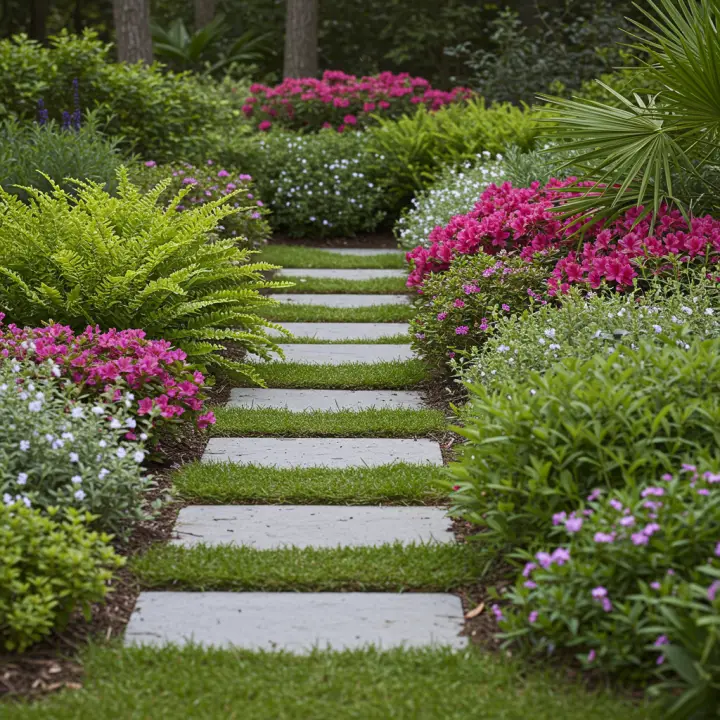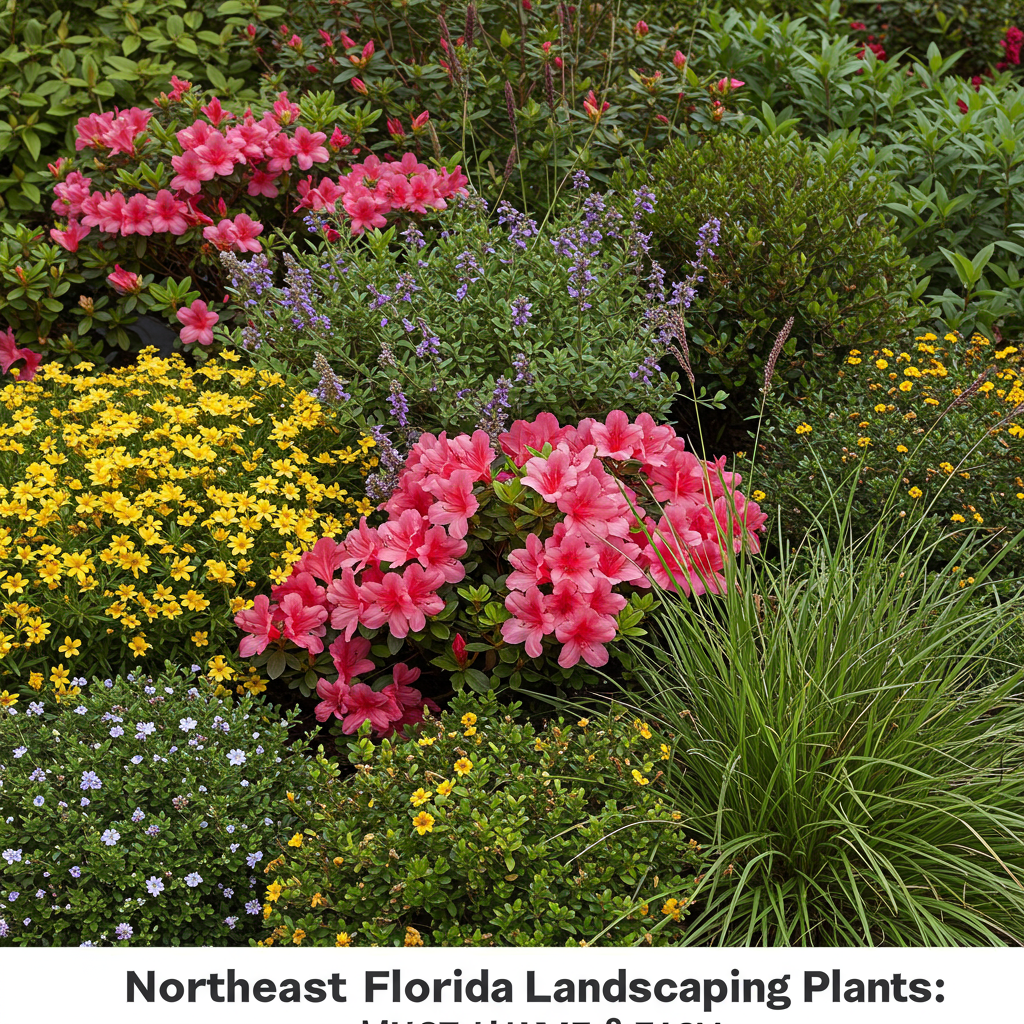Are you looking to create a beautiful, resilient garden in the Sunshine State? Discover the secret to a thriving landscape with Northeast Florida landscaping plants that are both essential and easy to maintain. This guide features native wonders, drought-tolerant beauties, and low-maintenance heroes perfectly suited for your local climate, ensuring year-round beauty without the fuss.
Unlocking Your Northeast Florida Garden’s Potential

Northeast Florida offers a unique landscape canvas, characterized by sandy soils, warm humid summers, and mild winters with occasional dips into chilly temperatures. Choosing the right plants is crucial for a garden that not only survives but truly flourishes. This guide will walk you through the must-have and easy-to-care-for plants that will transform your outdoor space into a vibrant haven, tailored specifically for our region’s climate.
Understanding Northeast Florida’s Unique Landscape Challenges
Our region, primarily USDA Hardiness Zones 8b and 9a, presents specific conditions that influence plant health and growth. These include:
Sandy Soils: Often nutrient-poor and quick-draining.
High Humidity: While beneficial for some, it can foster fungal issues in others.
Warm Summers: Long periods of intense heat and sun.
Mild Winters: But with the potential for occasional, damaging freezes.
Coastal Influences: Salt spray and sandy conditions for those near the ocean.
Selecting plants that are well-adapted to these conditions means less effort for you and a healthier, more beautiful garden.
Must-Have Northeast Florida Landscaping Plants for Every Garden
Whether you’re a seasoned gardener or just starting, these plants are top performers in our climate, offering beauty, resilience, and ease of care.
Native Powerhouses: Thriving with Minimal Effort
Native plants are perfectly adapted to our local climate, requiring less water, fertilizer, and pest control once established.
Coontie (Zamia integrifolia): A slow-growing, ancient cycad that’s extremely drought-tolerant and pest-resistant. Excellent for shady spots or as an accent.
Dune Sunflower (Helianthus debilis): A fast-growing groundcover with bright yellow blooms, ideal for sunny, sandy areas and attracting pollinators.
Firebush (Hamelia patens): A vibrant shrub with red-orange tubular flowers that are a hummingbird magnet. Tolerates sun and some shade.
Beautyberry (Callicarpa americana): Known for its stunning clusters of iridescent magenta berries in fall, providing seasonal interest.
Walters Viburnum (Viburnum obovatum): A versatile, fast-growing evergreen shrub that can be pruned into a hedge or small tree, offering white spring flowers.
Easy-Care for Busy Gardeners: Low Maintenance, High Impact
These plants provide significant visual appeal without demanding constant attention, making them ideal for busy homeowners.
Indian Hawthorn (Rhaphiolepis indica): A tough evergreen shrub with leathery leaves, pink or white spring flowers, and small berries. Great for hedges or foundation plantings.
Loropetalum (Loropetalum chinense): Features beautiful burgundy foliage and delicate pink fringe flowers. Many varieties offer different sizes and forms.
Azaleas (Rhododendron spp.): While some are finicky, many native and adapted varieties thrive here, providing spectacular spring blooms. Choose heat-tolerant options like Encore Azaleas.
Oleander (Nerium oleander): A robust, drought-tolerant shrub or small tree with showy flowers in various colors. Note: All parts are poisonous if ingested.
Lantana (Lantana camara): A tough, heat-loving perennial with clusters of multicolored flowers that attract butterflies. Can be a shrub or groundcover.
Drought-Tolerant Beauties: Save Water, Stay Green
Conserve water and still enjoy a lush garden with these resilient plants.
Yucca (Yucca filamentosa): Architectural evergreen plants with sword-like leaves and tall flower stalks. Extremely drought-tolerant once established.
Sago Palm (Cycas revoluta): A classic, slow-growing palm-like plant that thrives on neglect in well-drained soil.
Muhly Grass (Muhlenbergia capillaris): An ornamental grass creating a misty pink or purple cloud in fall, stunning in mass plantings.
Pentas (Pentas lanceolata): A perennial that blooms continuously in warm weather, offering nectar for butterflies and hummingbirds.
Sun-Loving Stars: Brightening Up Sunny Spots
Maximize the sunshine in your yard with plants that revel in full sun. Many of the drought-tolerant and easy-care options also fall into this category.
Bougainvillea (Bougainvillea glabra): A show-stopping vine with vibrant bracts in a range of colors, perfect for trellises or as a sprawling shrub.
Ixora (Ixora coccinea): A tropical evergreen shrub with clusters of bright red, orange, or pink flowers, ideal for hedges or accents.
Croton (Codiaeum variegatum): Prized for its dramatically colored foliage in shades of red, yellow, orange, and green, adding tropical flair.
Shade-Friendly Finds: Creating Lush Understories
Don’t let shady spots go bare! These plants will thrive where direct sunlight is limited.
Cast Iron Plant (Aspidistra elatior): As tough as its name suggests, this plant tolerates deep shade and neglect, perfect for difficult areas.
Farfugium (Farfugium japonicum): Large, glossy, rounded leaves create a bold texture, with some varieties offering unique spotting (e.g., ‘Leopard Plant’).
Mondo Grass (Ophiopogon japonicus): A low-growing, dark green groundcover perfect for edging or filling in shaded areas.
Foxtail Fern (Asparagus densiflorus ‘Myers’): An evergreen perennial with unique, upright “foxtail” plumes, excellent in containers or as a groundcover.
Camellia (Camellia japonica or C. sasanqua): Elegant evergreen shrubs known for their beautiful, waxy flowers in fall and winter.
Year-Round Interest: Keeping Your Landscape Vibrant
Select a variety of plants that offer different textures, bloom times, and evergreen foliage to ensure your garden remains captivating throughout the seasons. Combine evergreens like Indian Hawthorn with deciduous plants like Beautyberry for dynamic appeal.
Designing Your Northeast Florida Landscape: Tips for Success
A well-planned landscape considers both aesthetics and practicality.
Understand Your Microclimates: Observe sun exposure, wind patterns, and drainage in different parts of your yard.
Consider Mature Size: Always research how large a plant will get to avoid overcrowding or constant pruning.
Soil Amendments: While many local plants tolerate sandy soil, adding organic matter (compost) can significantly improve water retention and nutrient availability.
Layering: Group plants by height – tall plants in the back, medium in the middle, and low growers or groundcovers in the front – for visual depth.
Irrigation: Even drought-tolerant plants need regular watering during their establishment period (first year). Consider micro-irrigation for efficiency.
Essential Care Tips for Your Northeast Florida Plants
With the right plants selected, a few basic care practices will keep them healthy.
Watering Wisely: Deep, infrequent watering encourages strong root systems. Check soil moisture before watering.
Mulch, Mulch, Mulch: A 2-3 inch layer of organic mulch helps retain soil moisture, regulate soil temperature, and suppresses weeds.
Fertilize Sparingly: Many native and well-adapted plants require minimal fertilization. Use slow-release fertilizers designed for your specific plant types if needed.
Pruning: Prune to maintain shape, remove dead or diseased branches, and encourage new growth. Understand each plant’s specific pruning needs and timing.
* Pest and Disease Watch: Regularly inspect your plants for signs of stress, pests, or diseases. Early detection makes treatment easier.
Frequently Asked Questions (FAQs) About Northeast Florida Landscaping Plants
Q1: What is the best time to plant in Northeast Florida?
A1: The best times to plant are typically fall (October-November) or early spring (February-March). This allows plants to establish their root systems before the intense heat of summer or potential winter freezes.
Q2: How do I improve sandy soil for my new plants?
A2: The most effective way to improve sandy soil is by incorporating organic matter, such as compost, mushroom compost, or well-aged manure. This enhances water retention, provides nutrients, and improves soil structure.
Q3: Are native plants always the best choice for Northeast Florida landscaping?
A3: Native plants are often an excellent choice due to their adaptation to the local climate, reduced water needs, and support for local wildlife. However, many non-native, well-adapted plants also thrive here and offer a wider range of colors and forms. A balanced landscape often includes both.
Q4: How often should I water my new plants in Northeast Florida?
A4: During the establishment period (the first 6-12 months after planting), new plants typically need watering 2-3 times a week, especially if there’s no rain. After establishment, reduce frequency and water deeply when the top few inches of soil are dry. Always monitor your specific plant’s needs and current weather conditions.
Q5: Which landscaping plants are salt-tolerant for coastal Northeast Florida homes?
A5: For coastal areas, consider plants like Oleander, Indian Hawthorn, Muhly Grass, Sabal Palm (our state tree), Saw Palmetto, and some varieties of Lantana. These can better withstand salt spray and sandy, potentially saline conditions.
Conclusion: Cultivate Your Northeast Florida Oasis
Choosing the right Northeast Florida landscaping plants** is the first step towards creating a beautiful, sustainable, and low-maintenance outdoor space. By embracing native powerhouses, easy-care varieties, and plants suited to our unique climate challenges, you can enjoy a vibrant garden that thrives year after year. With thoughtful selection, good design, and consistent care, your Northeast Florida landscape will not only enhance your home’s curb appeal but also become a cherished oasis for you and our local wildlife. Happy gardening!

